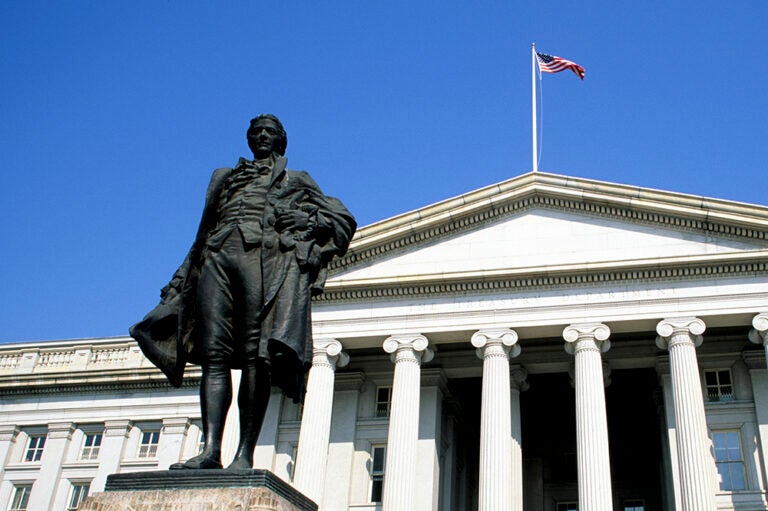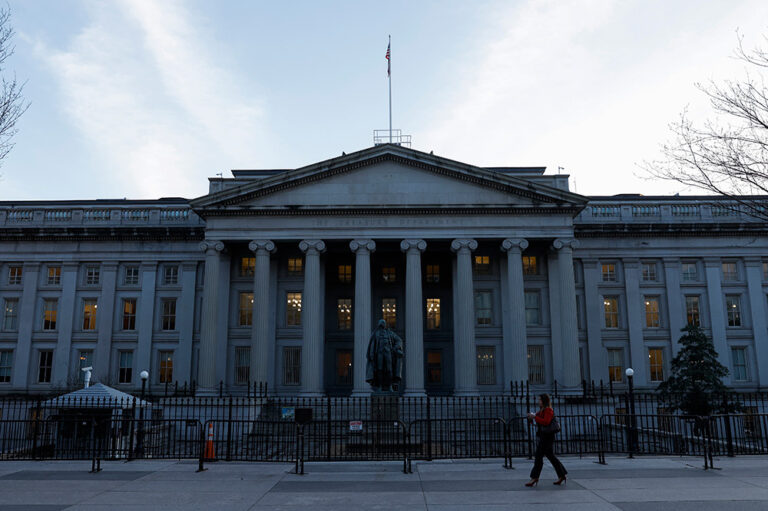On October 21, 2025, the nation’s gross debt eclipsed $38 trillion. Of that amount, approximately 80 percent, was debt held by the public — representing cash borrowed from domestic and foreign investors. The remaining 20 percent was intragovernmental debt, which simply records transactions between one part of the federal government and another.
Debt Held by the Public
Economists generally view debt held by the public (DHBP) as the most meaningful measure of debt, because it reflects the amount that the Treasury has borrowed from outside lenders through financial markets to support government activities. At high levels, DHBP can crowd out private investments in the economy, make it more difficult to respond to economic crises, and increase volatility within the economy.
As of the end of March 2025, the latest month for which breakdown data is available, DHBP was $29 trillion, or approaching 97 percent of GDP. That borrowing came from both domestic and foreign creditors, with the former holding more than two-thirds of it.
Domestic Holders of Federal Debt
Domestic holdings of federal debt have increased notably over the past decade, rising from $6.9 trillion in March 2015 to $19.9 trillion at the end of March 2025. The Federal Reserve, which purchases and sells Treasury securities as a means to influence federal interest rates and the nation’s money supply, is the largest holder of such debt.
In fact, the central bank doubled its holdings of Treasury securities during the COVID-19 pandemic as part of its effort to mitigate the economic impact of the pandemic. However, since June 2022, the Fed has been reducing the size of its balance sheet in response to high inflation and to adjust its needs related to the conduct of monetary policy.
Other domestic holders of public debt include investment funds (mutual and pension funds), commercial banks and other depository institutions, state and local governments, insurance companies, and other corporations and individuals.
Foreign Holders of Federal Debt
Foreign ownership of U.S. debt, which includes both governments and private investors, is now much higher than it was 50 years ago. In 1970, total foreign holdings accounted for $14.0 billion, or just 5 percent, of DHBP. As of June 2025, such holdings made up $9.1 trillion, or 32 percent, of DHBP. Because Treasury securities are backed by the full faith and credit of the U.S. government, creditors, including foreign investors, often view lending to the United States as a safe investment.
In recent years, however, the foreign share of DHBP has declined due to the rapid growth in purchases by the Federal Reserve in response to the economic effects of the COVID-19 pandemic. Foreign holdings were 49 percent of DHBP in 2011.
Investors in Japan and the United Kingdom hold significant shares of U.S. public debt. Together, as of June 2025, they accounted for $2.0 trillion, or 6.9 percent of DHBP. While the holdings of U.S. debt by both countries have declined over the past decade, China’s purchases of U.S. Treasury securities have declined more than Japan’s.
Foreign ownership of U.S. debt can have implications for the nation’s economy and financial markets. When foreign investors purchase Treasury securities, the federal government must send income abroad in the form of interest payments. On the one hand, that foreign investment may help increase U.S. economic activity if the money borrowed from such investors is used for productive purposes, such as stimulating recovery from a recession or funding investments in the nation’s economy. On the other hand, some analysts note that more foreign-owned debt reduces the control of financial markets in the United States and more income sent abroad means less is available for domestic investors.
Intragovernmental Debt
Intragovernmental debt records a transfer from one part of the government to another, and therefore, has no net effect on the government’s overall finances. As of August 2025, intragovernmental debt totaled $7.3 trillion, a $2.1 trillion increase from a decade ago. In almost all cases, such debt is held in government trust funds — accounting mechanisms to track money designated for a specific purpose or program.
The largest holder of intragovernmental debt is the Social Security Old-Age and Survivors Insurance Trust Fund, which holds $2.4 trillion, or 33 percent of intragovernmental debt, as of August 2025. Other accounts holding such debt include retirement funds for federal employees, Medicare’s Hospital Insurance Trust Fund, and the Highway Trust Fund.
What Does All This Debt Mean For the Federal Budget and the Economy?
The amount of federal debt issued to the public can affect the country’s fiscal and economic health in a number of ways. The nation’s high and rising levels of such debt can affect economic growth and pose a number of risks; it could:
- Reduce private investment and slow the growth of the economy
- Increase interest payments to foreign holders, thereby potentially reducing national income
- Elevate the risk of a fiscal crisis
- Lead to higher interest rates
- Constrain lawmakers from implementing policies to respond to crises or invest in the future
- Impede intergenerational equity by shifting debt to future generations and potentially restraining their ability to access public goods and services
Until lawmakers in Washington agree on a fiscally sustainable approach to the federal budget, public debt will continue to rise — threatening important safety net programs as well as domestic and foreign confidence in U.S. markets that can eventually chip away at economic opportunities for Americans.
Photo by Jemal Countess/Getty Images for the Peter G. Peterson Foundation
Further Reading
The Fed Reduced the Short-Term Rate Again, but Interest Costs Remain High
High interest rates on U.S. Treasury securities increase the federal government’s borrowing costs.
What Types of Securities Does the Treasury Issue?
Learn about the different types of Treasury securities issued to the public as well as trends in interest rates and maturity terms.
Quarterly Treasury Refunding Statement: Borrowing Up Year Over Year
Key highlights from the most recent Quarterly Refunding include an increase in anticipated borrowing of $158 billion compared to the same period in the previous year.


